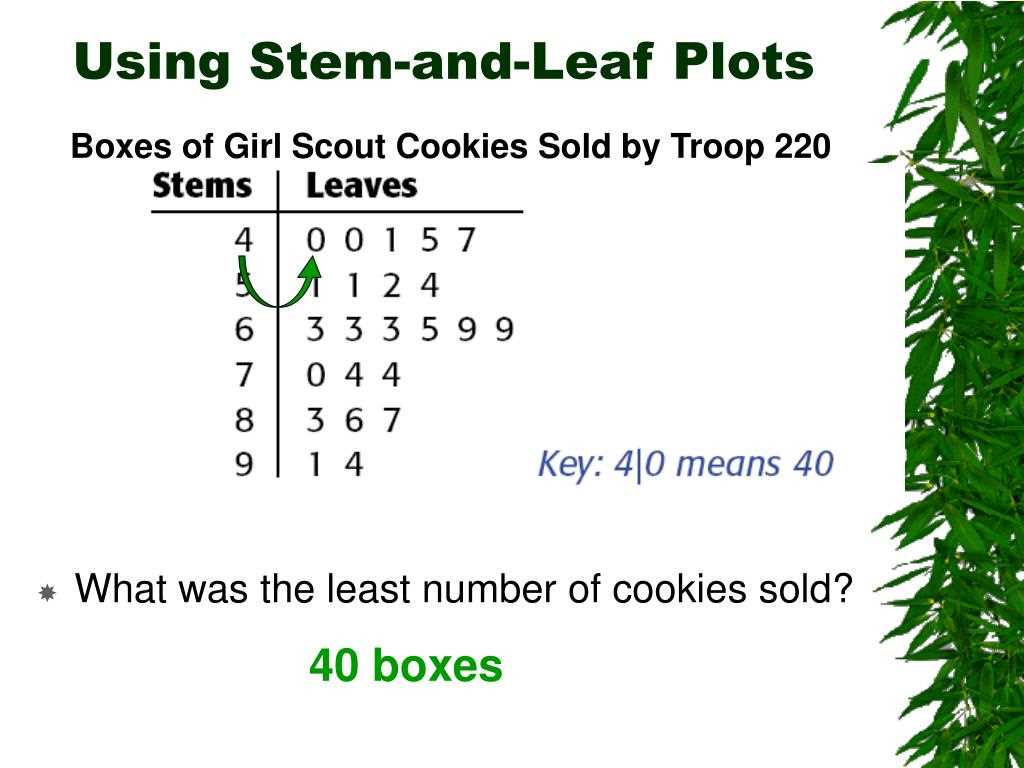
In the world of statistics and data analysis, stem and leaf plots are fundamental tools used to organize and display data. Stem and leaf plots provide a visual representation of data sets, making it easier to understand and analyze the distribution of values.
A stem and leaf plot consists of a “stem” column and a “leaf” column. The stem column represents the tens or hundreds place digits of the data values, while the leaf column represents the ones place digit. The stem and leaf plot worksheet helps students practice creating and interpreting stem and leaf plots.
This answer key provides the correct solutions to the stem and leaf plot worksheet, allowing students to check their work and verify their understanding. By comparing their answers to the answer key, students can identify any mistakes or misunderstandings they may have and seek clarification on those concepts.
What Is a Stem and Leaf Plot?
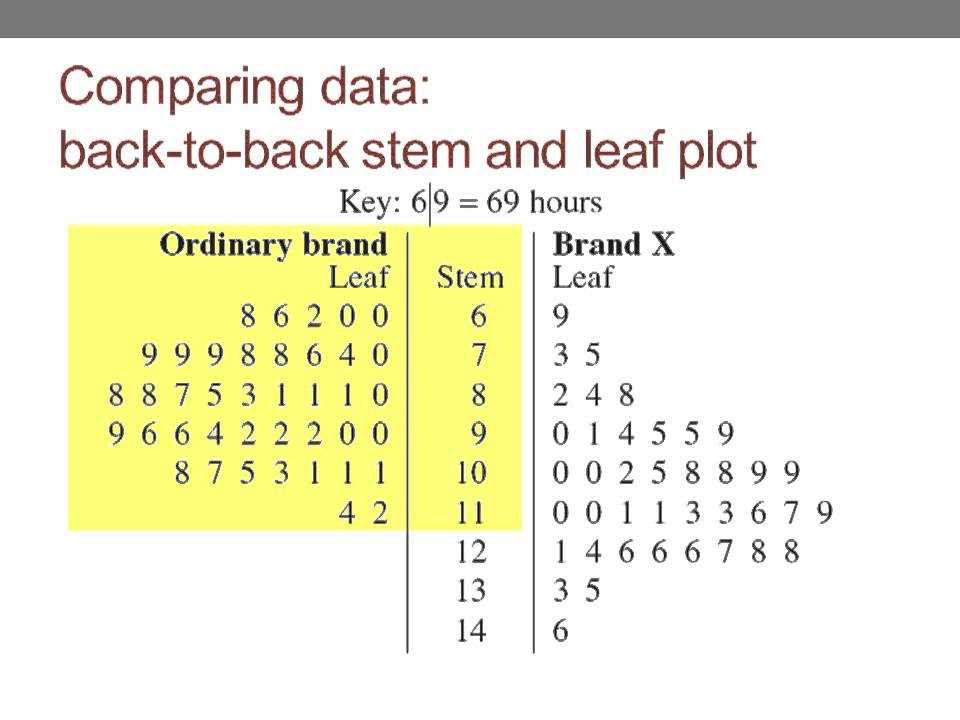
A stem and leaf plot is a visual representation of data that organizes and displays the individual values in a dataset. It is particularly useful for displaying large sets of data and can provide insights into the distribution and patterns within the data. The plot consists of two parts: the stem and the leaf.
The stem is a column on the left side of the plot and represents the tens or hundreds place of the data values. Each stem contains one or more leaves, which are the individual data points. The leaves are written to the right of the stem, in ascending order.
The stem and leaf plot allows for easy comparison of data values, as well as identification of outliers, clusters, and patterns. It is especially useful in situations where a large range of values is present, as it condenses the data and provides a clear representation of the distribution.
To create a stem and leaf plot, the data is first sorted in ascending order. Then, the stems are listed vertically in a column. The leaves are written in a row next to the corresponding stem. The process continues until all the data values have been included. The resulting plot can be read from left to right to determine the actual values of the data points.
Overall, stem and leaf plots are a valuable tool for data analysis and visualization, providing a clear and concise representation of the dataset’s distribution and enabling insights into the underlying patterns and trends.
Understanding the Basics of Stem and Leaf Plots
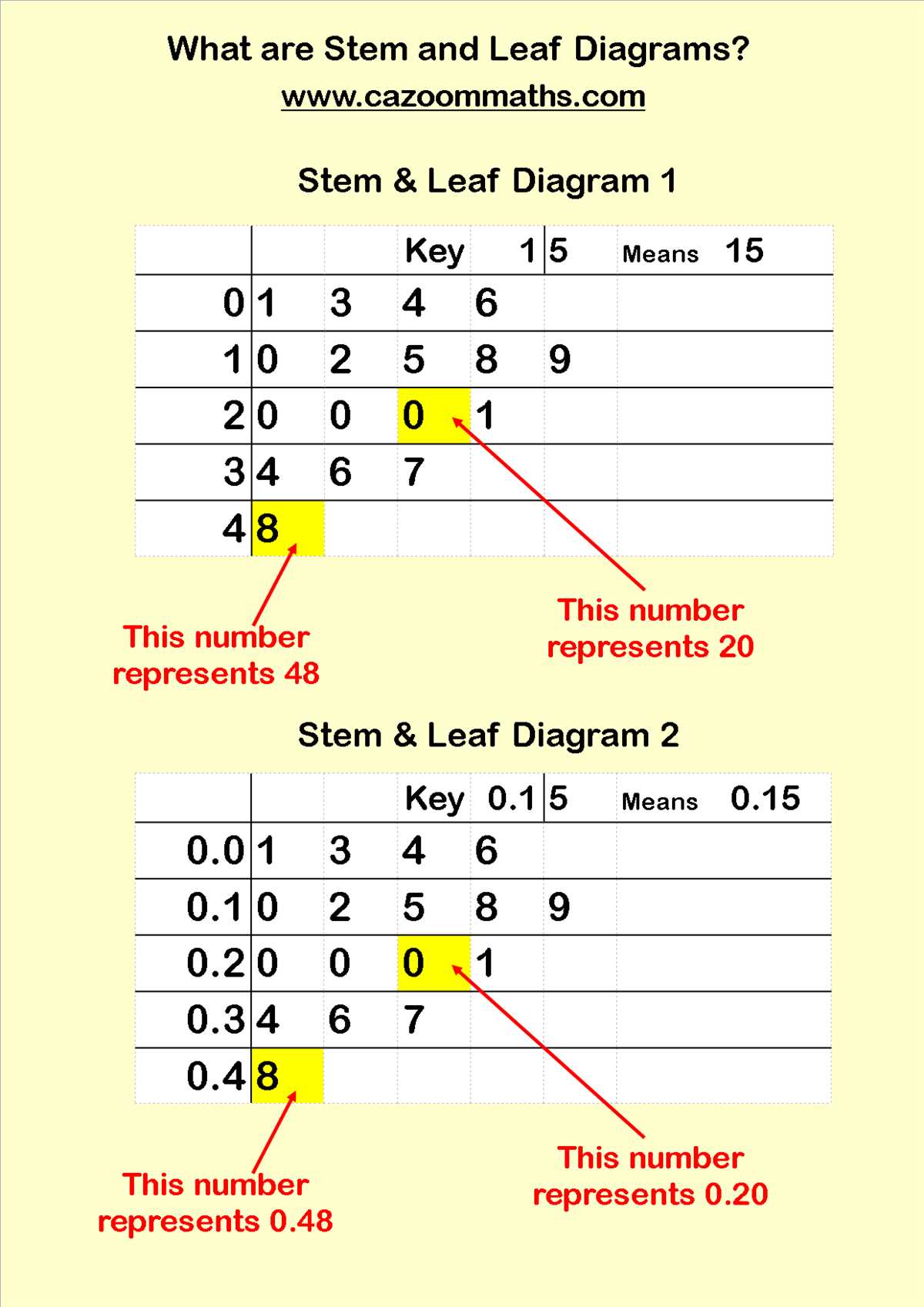
A stem and leaf plot is a data visualization tool that organizes numerical data in a way that allows us to see the distribution and patterns in the data. It is particularly useful when working with small to moderate amounts of data, as it provides a clear and concise representation.
To create a stem and leaf plot, we divide each data point into two parts: the stem and the leaf. The stem represents the leading digit(s) of the data point, while the leaf represents the trailing digit(s). For example, if we have the data points 12, 23, 34, 45, and 56, the stems would be 1, 2, 3, 4, and 5, while the leaves would be 2, 3, 4, 5, and 6.
To construct a stem and leaf plot:
- Write out the stems vertically in ascending order.
- Write the leaves next to the corresponding stem, in ascending order.
- Ensure that each stem has all the leaves listed next to it.
- Add a key to the plot to indicate the scale (e.g., 1|2 = 12).
The stem and leaf plot provides a visual representation of the data, allowing us to quickly identify the range, the distribution, and any outliers. We can easily determine the mode(s), median, and quartiles from the plot. Additionally, we can compare multiple sets of data by creating side-by-side plots or back-to-back plots.
How to Construct a Stem and Leaf Plot
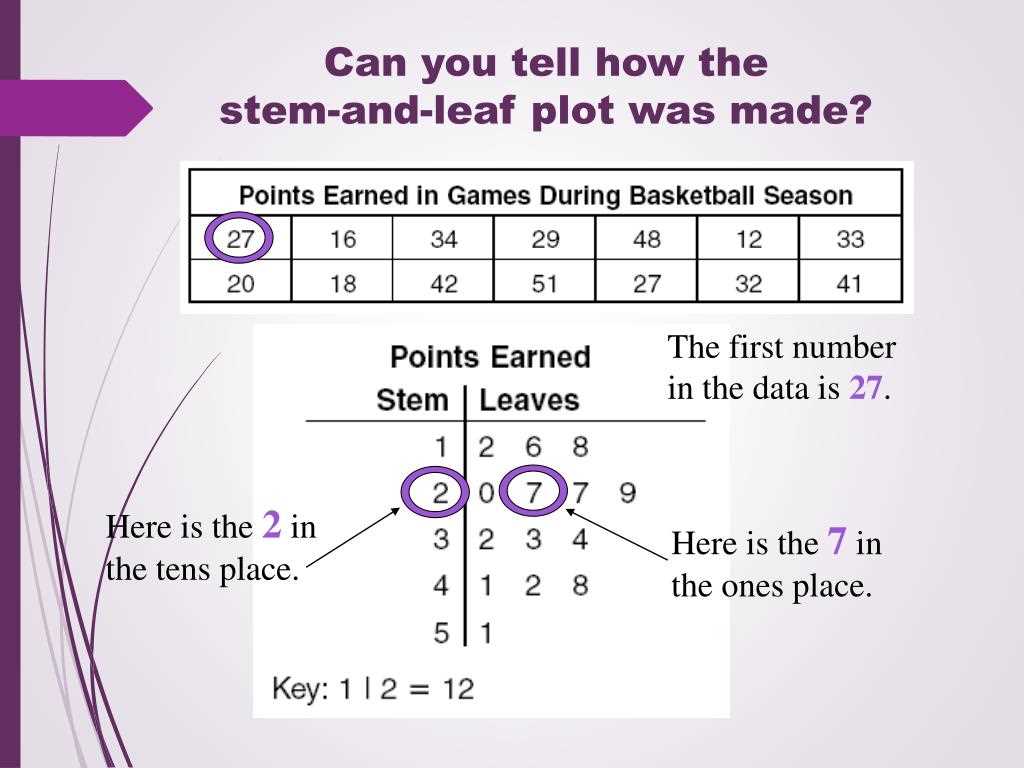
To construct a stem and leaf plot, follow these steps:
- Gather your data: Collect all the data values that you want to represent in the stem and leaf plot. Make sure that the data values are numerical.
- Determine the stem and leaf: The stem represents the leading digits of each data value, while the leaf represents the last digit. For example, if your data values range from 10 to 99, the stems will be the tens digit (1, 2, 3, …), and the leaves will be the ones digit (0-9).
- Arrange the stems and leaves: Sort your data values from least to greatest. Write the stems in a column on the left side of the plot, and write the corresponding leaves next to each stem.
- Identify the outliers: Look for any data values that deviate significantly from the rest. These outliers can be identified by looking for stems or leaves that are repeated or missing in the plot.
- Add a key: Include a key that explains the scale of the plot. For example, if each stem represents 10 units and each leaf represents 1 unit, make sure to indicate this in the key.
By following these steps, you can easily construct a stem and leaf plot to display your numerical data in a clear and organized manner.
Interpreting Data from a Stem and Leaf Plot
When analyzing data, a stem and leaf plot can be a helpful tool. This type of graph represents a set of data by splitting the numbers into stems and leaves. The stem represents the first digit or digits of the numbers, while the leaf represents the remaining digits. By organizing the data in this way, it becomes easier to identify patterns and trends.
To interpret the data from a stem and leaf plot, it is important to understand how the numbers are represented. For example, in a stem and leaf plot with a stem of 10, the values in the “1” row represent numbers from 10 to 19, the values in the “2” row represent numbers from 20 to 29, and so on. The leaves then indicate the specific values within each range.
By examining the stem and leaf plot, one can easily determine the frequency of certain numbers. For instance, if there are a large number of leaves in the “3” row and very few in the “7” row, it suggests that the data contains more numbers in the 30s range than the 70s range. This information can be useful when comparing data sets or identifying outliers.
Another way to interpret the data from a stem and leaf plot is by examining the overall spread and distribution of the numbers. If the leaves are evenly spread out across the different stems, it indicates a relatively uniform distribution of the data. On the other hand, if there are clusters of leaves in certain stems, it suggests a concentration of values around those particular numbers.
In conclusion, a stem and leaf plot provides a visual representation of data that can assist in interpreting and analyzing the numbers. By understanding how the numbers are organized and examining the frequency, spread, and distribution, one can gain valuable insights from a stem and leaf plot.
Why Use a Stem and Leaf Plot Worksheet?
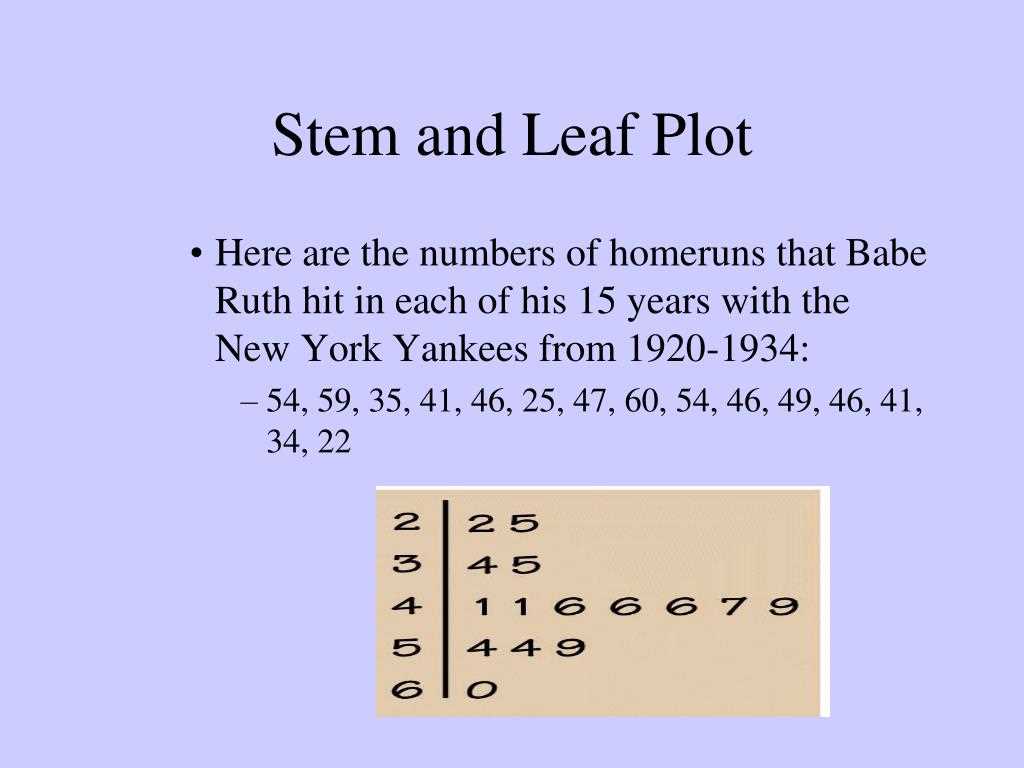
A stem and leaf plot is a type of data visualization that can be used to organize and display numerical data. It provides a convenient way to summarize and analyze large sets of data, making it easier to identify patterns and trends. The use of a stem and leaf plot worksheet can be beneficial for students and professionals alike.
One of the main advantages of using a stem and leaf plot worksheet is that it allows for easy data entry and organization. The worksheet typically includes a vertical column for the stems and a horizontal row for the leaves. By filling in the appropriate numbers in each section, users can quickly build a visual representation of their data. This can save time and effort compared to manually drawing a stem and leaf plot on paper.
Additionally, using a stem and leaf plot worksheet can help students develop their data analysis skills. By working with a structured worksheet, students can practice identifying key features of the data, such as the range, median, and mode. They can also learn how to interpret the plot to draw conclusions and make predictions. This hands-on experience can enhance their understanding of data visualization and support their overall learning in math and statistics.
Furthermore, a stem and leaf plot worksheet can be a useful tool in professional settings. It can be used to analyze data in various fields, including finance, sales, and research. The clear and concise display of information can make it easier for professionals to communicate their findings and make informed decisions based on the data. In addition, using a worksheet can help ensure accuracy and consistency when working with large datasets.
In conclusion, using a stem and leaf plot worksheet offers several benefits. It provides a structured and efficient way to organize and analyze numerical data. Whether used in educational or professional settings, a stem and leaf plot worksheet can enhance data analysis skills and facilitate clear communication of findings.
Answer Key for a Stem and Leaf Plot Worksheet
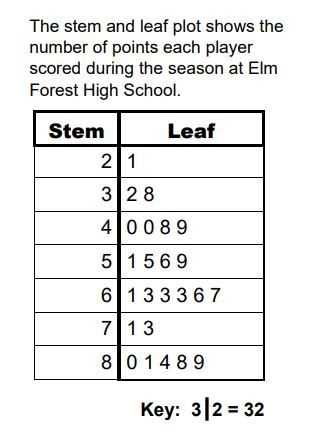
A stem and leaf plot is a visual representation of data that allows us to organize and analyze a large set of numbers. It helps us identify the distribution of values and find patterns or outliers in the data.
In a stem and leaf plot, the data is divided into two parts: the stem, which represents the tens or hundreds place of the numbers, and the leaves, which represent the ones place. This format makes it easy to read and compare the values.
Here is the answer key for the stem and leaf plot worksheet:
| Stem | Leaves |
|---|---|
| 1 | 3, 5, 9 |
| 2 | 0, 2, 3, 4, 5, 6, 7, 8, 9 |
| 3 | 1, 1, 2, 3, 4, 4, 5, 6, 7, 8, 9, 9 |
The stem and leaf plot shows that the data set includes numbers ranging from 10 to 39. The stem 1 represents the values 10-19, the stem 2 represents the values 20-29, and the stem 3 represents the values 30-39.
The leaves in each row indicate the individual values within each stem. For example, in the first row, the stem 1 has leaves 3, 5, and 9. This means that the numbers 13, 15, and 19 are part of the data set.
By analyzing the stem and leaf plot, we can see that the data set has a relatively even distribution, with no significant outliers. The majority of values are between 20 and 29, with a few values in the range of 10-19 and 30-39. This information can help us understand the nature of the data and draw conclusions about the population it represents.
Using a stem and leaf plot can be a useful tool for data analysis. It provides a clear and organized representation of the data, allowing us to easily identify patterns and outliers. By interpreting the plot, we can gain insight into the underlying characteristics of the data set and make informed decisions based on our findings.
Q&A:
What is an answer key for a stem and leaf plot worksheet?
An answer key for a stem and leaf plot worksheet is a guide that provides the correct solutions or responses to the questions or exercises on the worksheet.
Why is an answer key important for a stem and leaf plot worksheet?
An answer key is important for a stem and leaf plot worksheet because it allows students to check their work and verify if they have correctly identified the stems and leaves and calculated the values or statistics associated with the stem and leaf plot.
How can an answer key be used for a stem and leaf plot worksheet?
An answer key for a stem and leaf plot worksheet can be used by comparing the student’s answers with the provided correct solutions. If there are any discrepancies or errors, the student can review their work and correct any mistakes.
Where can you find an answer key for a stem and leaf plot worksheet?
An answer key for a stem and leaf plot worksheet can often be found alongside the worksheet itself. It may be provided by the teacher or available in textbooks, online resources, or educational websites.
What should you do if an answer key for a stem and leaf plot worksheet is not available?
If an answer key for a stem and leaf plot worksheet is not available, it is recommended to consult with the teacher or instructor for guidance and clarification on the correct answers. They may be able to provide additional assistance or explanations.